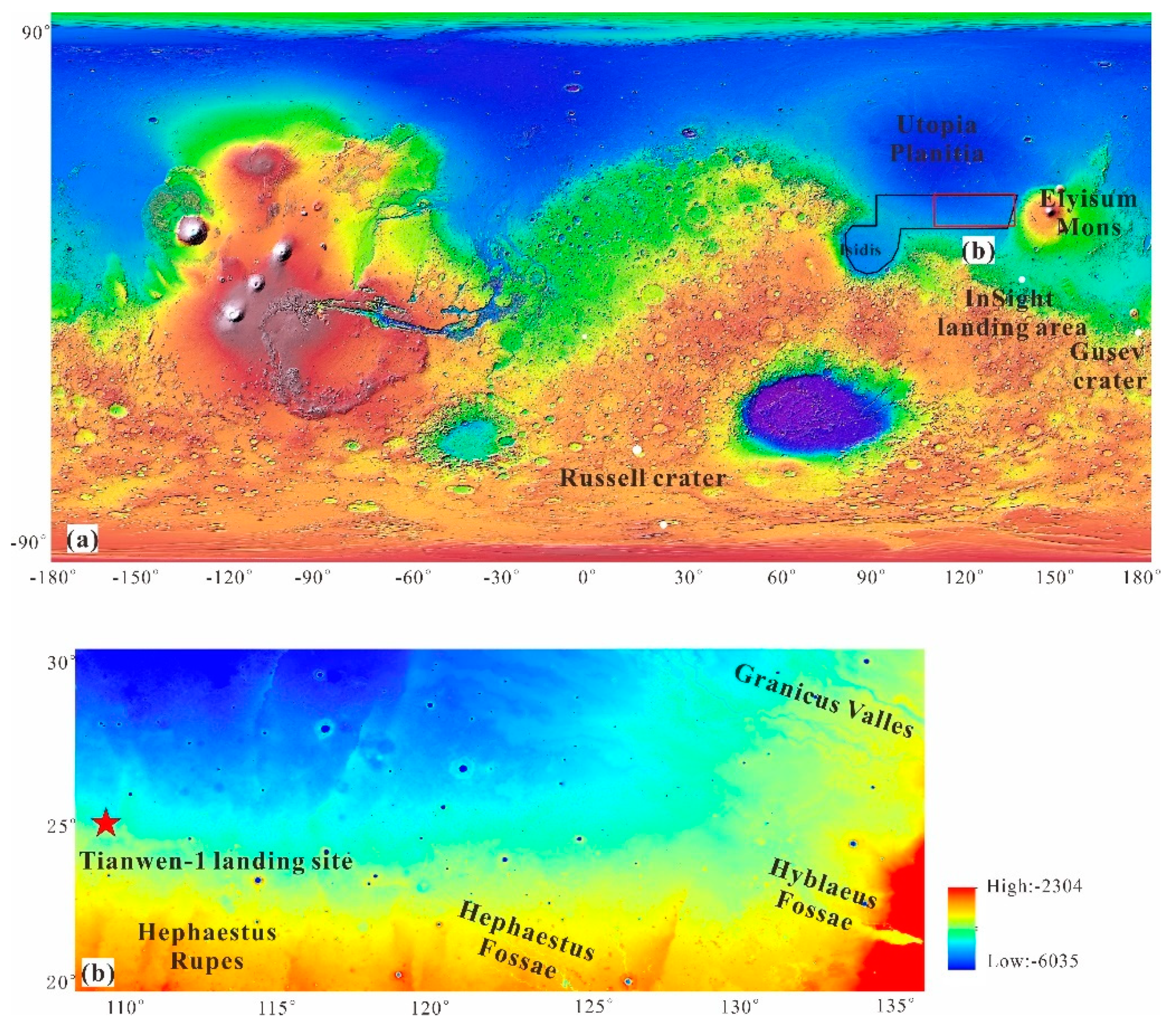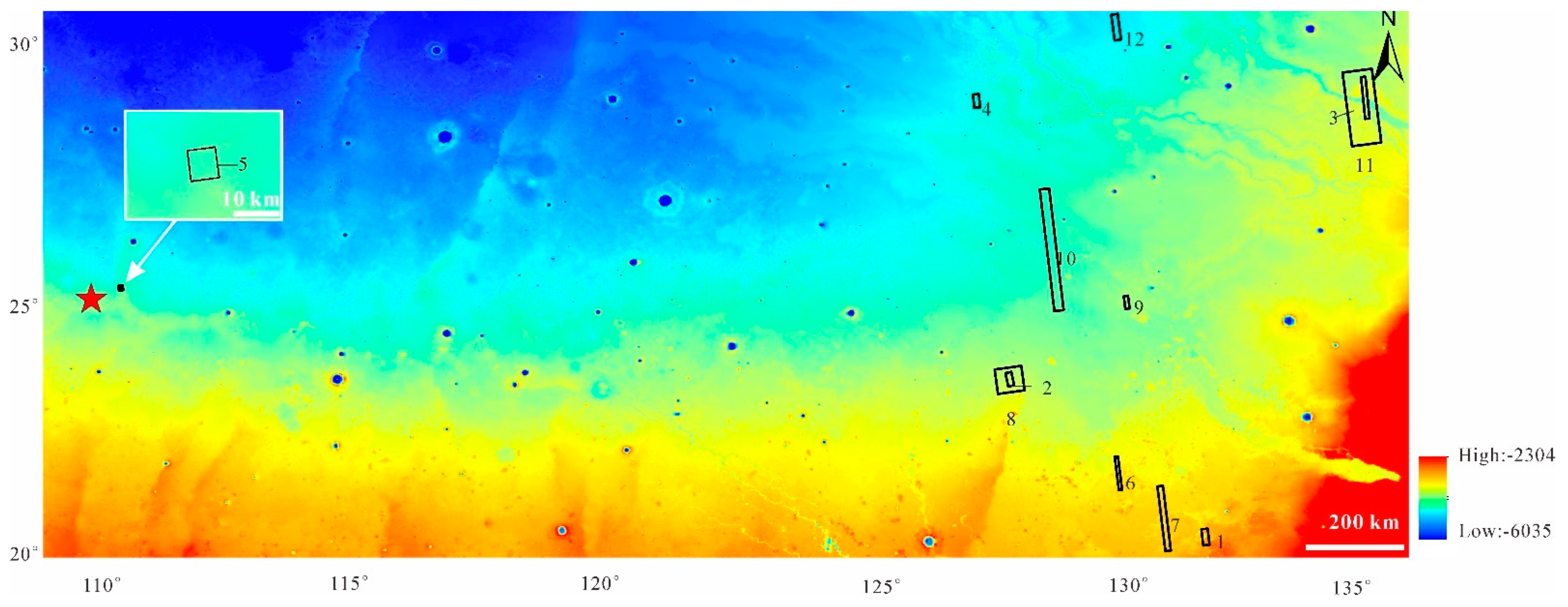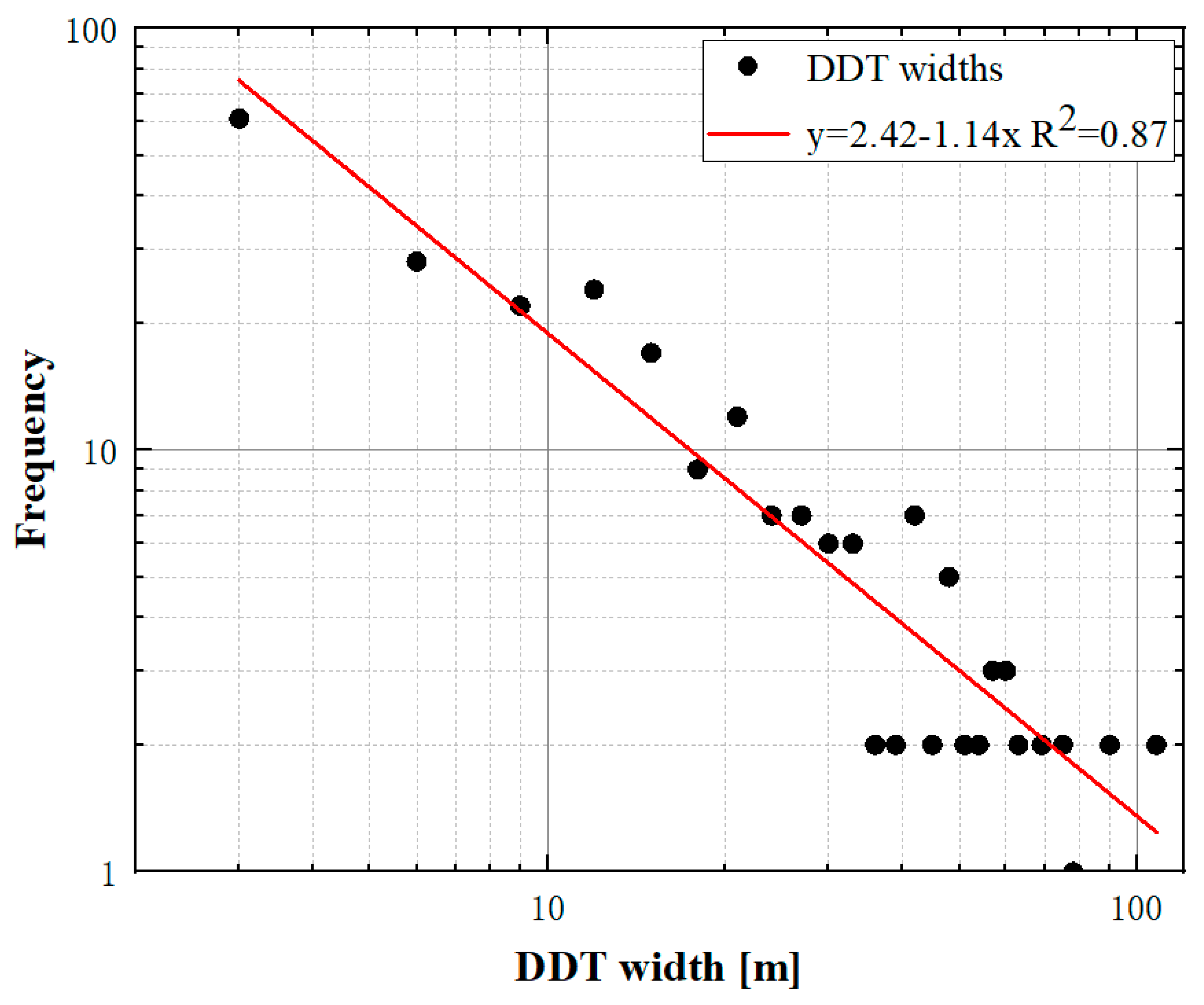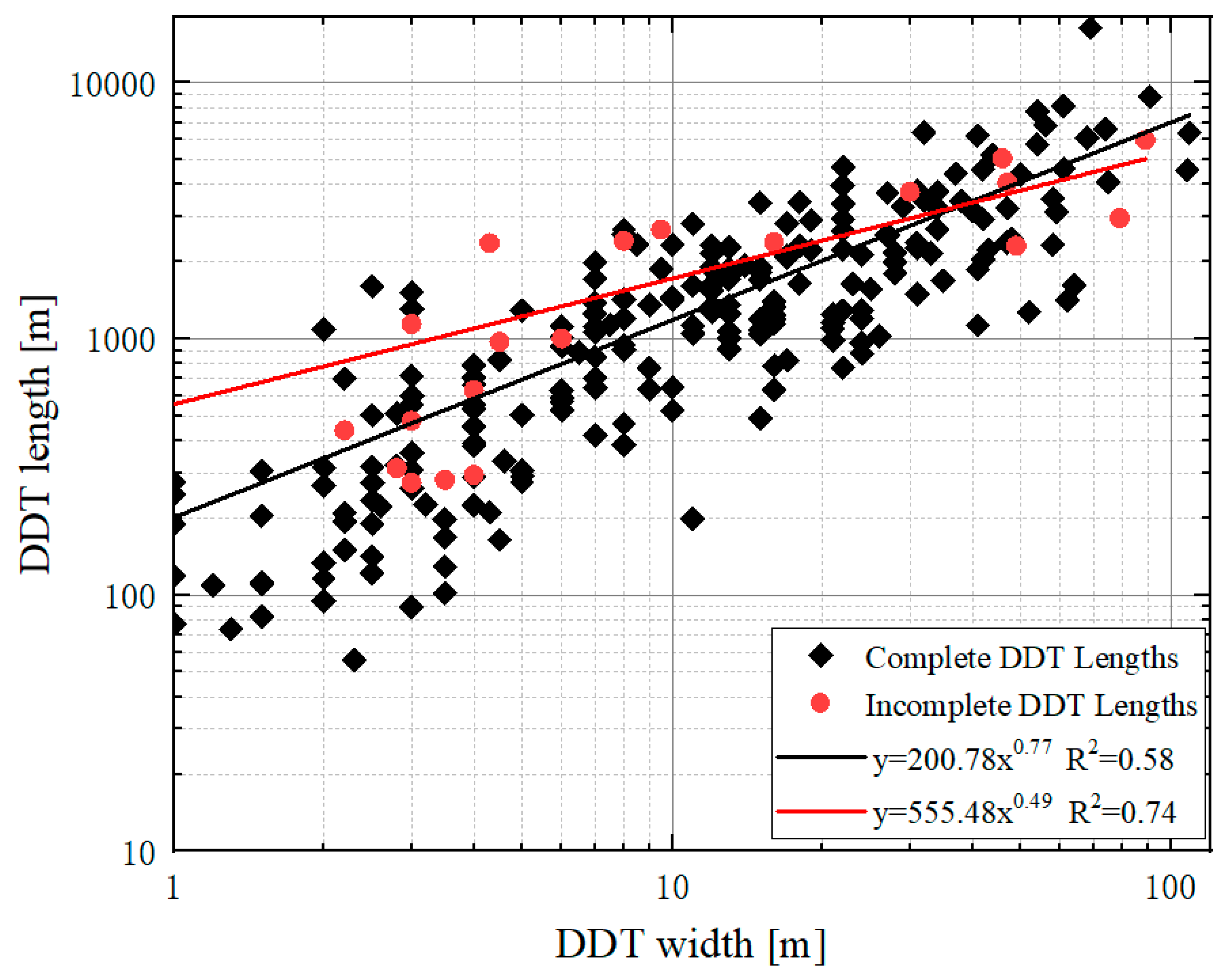The Preliminary Study of Dust Devil Tracks in Southern Utopia Planitia, Landing Area of Tianwen-1 Mission
Abstract
:1. Introduction
2. Methods
2.1. Image Pairs Selection
2.2. Methods
3. Results and Discussion
3.1. Dust Devil Track Sinuosity
3.2. DDT Direction
3.3. Sizes of Dust Devil Tracks
3.3.1. Dust Devil Track Widths
3.3.2. The Lengths of Dust Devil Tracks
3.4. DDT Formation Rates
3.5. The Prediction of Solar Panel Clearing Recurrence Interval
3.6. Tianwen-1 Landing Area Evaluation Based on Dust Devils
4. Summaries
Author Contributions
Funding
Institutional Review Board Statement
Informed Consent Statement
Data Availability Statement
Acknowledgments
Conflicts of Interest
References
- Balme, M.; Greeley, R. Dust devils on earth and mars. Rev. Geophys. 2006, 44. [Google Scholar] [CrossRef]
- Thomas, P.; Gierasch, P.J. Dust devils on Mars. Science 1985, 230, 175–177. [Google Scholar] [CrossRef] [PubMed]
- Smith, P.H.; Lemmon, M. Opacity of the Martian atmosphere measured by the Imager for Mars Pathfinder. J. Geophys. Res. Planets 1999, 104, 8975–8985. [Google Scholar] [CrossRef] [Green Version]
- Malin, M.C.; Edgett, K.S. Mars Global Surveyor Mars Orbiter Camera: Interplanetary cruise through prima-ry mission. J. Geophys. Res. Planets 2001, 106, 23429–23570. [Google Scholar] [CrossRef]
- Greeley, R.; Arvidson, R.; Bell, J.F.; Christensen, P.; Sullivan, R. Martian variable features: New insight from the mars express orbiter and the mars exploration rover spirit. J. Geophys. Res. Atmos. 2005, 110. [Google Scholar] [CrossRef] [Green Version]
- Reiss, D.; Raack, J.; Rossi, A.P.; Achille, G.D.; Hiesinger, H. First in-situ analysis of dust devil tracks on earth and their comparison with tracks on mars. Geophys. Res. Lett. 2010, 37, L14230. [Google Scholar] [CrossRef]
- Reiss, D.; Fenton, L.; Neakrase, L.; Zimmerman, M.; Statella, T.; Whelley, P.; Rossi, A.P.; Balme, M. Dust Devil Tracks. Space Sci. Rev. 2016, 203, 143–181. [Google Scholar] [CrossRef] [Green Version]
- Battersby, S. Pathfinder probes the weather on Mars. Nature 1997, 388, 612. [Google Scholar] [CrossRef]
- Landis, G.A.; Jenkins, P.P. Measurement of the settling rate of atmospheric dust on Mars by the MAE instrument on Mars Pathfinder. J. Geophys. Res. Planets 2000, 105, 1855–1857. [Google Scholar] [CrossRef]
- Squyres, S.W.; Arvidson, R.; Bell, J.F., III; Carr, M.; Christensen, P.; DesMarais, D.; Economou, T.; Gorevan, S.; Klingelhoefer, G.; Haskin, L. The Athena Mars Rover Science Payload. In Proceedings of the Lunar and Planetary Science Conference, Houston, TX, USA, 17–21 March 1997. [Google Scholar]
- Vaughan, A.F.; Johnson, J.R.; Herkenhoff, K.E.; Sullivan, R.; Madsen, M.B. Pancam and Microscopic Imager Observations of Dust on the Spirit Rover: Cleaning Events, Spectral Properties, and Aggregates; Center for Integrated Data Analytics Wisconsin Science Center: Madison, WI, USA, 2010. [Google Scholar]
- Banfield, D.; Spiga, A.; Newman, C.; Forget, F.; Lemmon, M.; Lorenz, R.; Murdoch, N.; Viudez-Moreiras, D.; Pla-Garcia, J.; Garcia, R.F.; et al. The atmosphere of Mars as observed by InSight. Nat. Geosci. 2020, 13, 190–198. [Google Scholar] [CrossRef]
- Lorenz, R.D.; Reiss, D. Solar panel clearing events, dust devil tracks, and in-situ vortex detections on Mars. Icarus 2015, 248, 162–164. [Google Scholar] [CrossRef]
- Korablev, O.; Olsen, K.S.; Trokhimovskiy, A.; Lefèvre, F.; Vandaele, A.C. Transient hcl in the atmosphere of mars. Sci. Adv. 2021, 7, eabe4386. [Google Scholar] [CrossRef]
- Liuzzi, G.; Villanueva, G.L.; Viscardy, S.; Mège, D.; Vandaele, A.C. Probing the atmospheric cl isotopic ratio on mars: Implications for planetary evolution and atmospheric chemistry. Geophys. Res. Lett. 2021, 48, e2021GL092650. [Google Scholar] [CrossRef]
- Whelley, P.L.; Greeley, R. The distribution of dust devil activity on Mars. J. Geophys. Res. 2008, 113, E07002. [Google Scholar] [CrossRef]
- Balme, M.R.; Whelley, P.L.; Greeley, R. Mars: Dust devil track survey in Argyre Planitia and Hellas Basin. J. Geophys. Res. Planets 2003, 108. [Google Scholar] [CrossRef]
- Verba, C.A.; Geissler, P.E.; Titus, T.N.; Waller, D. Observations from the High Resolution Imaging Science Experiment (HiRISE): Martian dust devils in Gusev and Russell craters. J. Geophys. Res. Planets 2010, 115. [Google Scholar] [CrossRef] [Green Version]
- Reiss, D.; Lorenz, R.D. Dust devil track survey at Elysium Planitia, Mars: Implications for the InSight land-ing sites. Icarus 2016, 266, 315–330. [Google Scholar] [CrossRef]
- Perrin, C.; Rodriguez, S.; Jacob, A.; Lucas, A.; Spiga, A.; Murdoch, N.; Lorenz, R.; Daubar, I.J.; Pan, L.; Kawamura, T.; et al. Monitoring of Dust Devil Tracks Around the InSight Landing Site, Mars, and Comparison with in situ Atmospheric Data. Geophys. Res. Lett. 2020, 47, e2020GL087234. [Google Scholar] [CrossRef]
- Fisher, J.A.; Richardson, M.I.; Newman, C.E.; Szwast, M.A.; Graf, C.; Basu, S.; Ewald, S.P.; Toigo, A.D.; Wilson, R.J. A survey of Martian dust devil activity using Mars Global Surveyor Mars Orbiter Camera im-ages. J. Geophys. Res. Planets 2005, 110. [Google Scholar] [CrossRef] [Green Version]
- McEwen, A.S.; Eliason, E.M.; Bergstrom, J.W.; Bridges, N.T.; Hansen, C.J.; Delamere, W.A.; Grant, J.A.; Gulick, V.C.; Herkenhoff, K.E.; Keszthelyi, L.; et al. Mars Reconnaissance Orbiter’s High Resolution Imaging Science Experiment (HiRISE). J. Geophys. Res. Atmos. 2007, 112, 5. [Google Scholar] [CrossRef] [Green Version]
- Malin, M.C.; Bell, J.F., III; Cantor, B.A.; Caplinger, M.A.; Calvin, W.M.; Clancy, R.T.; Edgett, K.S.; Edwards, L.; Haberle, R.M.; James, P.B.; et al. Context Camera Investigation on board the Mars Reconnaissance Orbiter. J. Geophys. Res. Planets 2007, 112, E05S04. [Google Scholar] [CrossRef] [Green Version]
- Ye, P.J.; Sun, Z.Z.; Rao, W.; Meng, L.Z. Mission overview and key technologies of the first Mars probe of China. Sci. China Technol. Sci. 2017, 60, 649–657. [Google Scholar] [CrossRef]
- Wan, W.X.; Wang, C.; Li, C.L.; Wei, Y. China’s first mission to Mars. Nat. Astron. 2020, 4, 721. [Google Scholar] [CrossRef]
- Cantor, B.A.; Kanak, K.M.; Edgettet, K.S. Mars Orbiter Camera observations of Martian dust devils and their tracks (September 1997 to January 2006) and evaluation of theoretical vortex models. J. Geophys. Res. Planets 2006, 111. [Google Scholar] [CrossRef]
- Ives, R.L. Behavior of dust devils. Bull. Am. Meteorol. Soc. 1947, 28, 168–174. [Google Scholar] [CrossRef] [Green Version]
- Balme, M.R.; Pathare, A.; Metzger, S.M.; Towner, M.C.; Lewis, S.R.; Spiga, A.; Fenton, L.K.; Renno, N.O.; Elliott, H.M.; Saca, F.A.; et al. Field measurements of horizontal forward motion velocities of terrestrial dust devils: To-wards a proxy for ambient winds on Mars and Earth. Icarus 2012, 221, 632–645. [Google Scholar] [CrossRef] [Green Version]
- Reiss, D.; Spiga, A.; Erkeling, G. The horizontal motion of dust devils on Mars derived from CRISM and CTX/HiRISE observa-tions. Icarus 2014, 227, 8–20. [Google Scholar] [CrossRef]
- Forget, F.; Hourdin, F.; Fournier, R.; Hourdin, C.; Talagrand, O.; Collins, M.; Lewis, S.R.; Read, P.L.; Huot, J.-P. Improved general circulation models of the martian atmosphere from the surface to above 80 km. J. Geophys. Res. Planets 1999, 104, 24155–24175. [Google Scholar] [CrossRef]
- Millour, E.; Forget, F.; Spiga, A.; Vals, M.; Zakharov, V.; Montabone, L.; Lefèvre, F.; Montmessin, F.; Chaufray, J.Y.; López-Valverde, M.A.; et al. The Mars Climate Database (version 5.3). Presented at From Mars Express to ExoMars Scientific Workshop, ESA-ESAC, Madrid, Spain, 27–28 February 2018. [Google Scholar]
- Lorenz, R.D. Power law of dust devil diameters on Mars and Earth. Icarus 2009, 203, 683–684. [Google Scholar] [CrossRef]
- Luo, Y.; Yan, J.; Li, F.; Li, B. Spatial Autocorrelation of Martian Surface Temperature and Its Spatio-Temporal Relationships with Near-Surface Environmental Factors across China’s Tianwen-1 Landing Zone. Remote Sens. 2021, 13, 2206. [Google Scholar] [CrossRef]
- Lorenz, R.D. The longevity and aspect ratio of dust devils: Effects on detection efficiencies and comparison of landed and orbital imaging at mars. Icarus 2013, 226, 964–970. [Google Scholar] [CrossRef]
- Spiga, A.; Banfield, D.; Teanby, N.A.; Forget, F.; Lucas, A.; Kenda, B.; Manfredi, J.A.R.; Widmer-Schnidrig, R.; Murdoch, N.; Lemmon, M.T.; et al. Atmospheric Science with InSight. Space Sci. Rev. 2018, 214, 1–64. [Google Scholar] [CrossRef] [Green Version]
- Yao, P.; Li, C.; Wang, B.; Li, B.; Zhang, J.; Ling, Z.; Chen, S. Evaluating the Dust Storm Probability in Isidis-lysium Planitia, a Tentative Landing Area of Chi-na’s First Mars Mission (Tianwen-1). Earth Space Sci. 2020, 7, e2020EA001242. [Google Scholar] [CrossRef]
- Zou, Y.; Zhu, Y.; Bai, Y.; Wang, L.; Peng, Y.; Jia, Y.Z.; Shen, W.H.; Fan, Y.; Liu, Y.; Wang, C.; et al. Scientific objectives and payloads of tianwen-1, china’s first mars exploration mission. Adv. Space Res. 2020, 67, 812–823. [Google Scholar] [CrossRef]
- Renno, N.O.; Abreu, V.J.; Koch, J.; Smith, P.H.; Hartogensis, O.K.; De Bruin, H.A.R.; Burose, D.; Delory, G.T.; Farrell, W.M.; Watts, C.J.; et al. MATADOR 2002: A pilot field experiment on convective plumes and dust devils. J. Geophys. Res. Planets 2004, 107. [Google Scholar] [CrossRef] [Green Version]
- Tian, H.; Zhang, T.; Jia, Y.; Peng, S.; Yan, C. Zhurong: Features and mission of China’s first Mars rover. Innovation 2021, 100121. [Google Scholar] [CrossRef]







| Index | HiRISE/CTX ID | Spatial Resolution (m pixel−1) | Number of New DDTs | Average Width (m) | Average Length (m) | Average Sinuosity | Time Interval (Sols) |
|---|---|---|---|---|---|---|---|
| 1 | ESP_018353_2005 | 0.25 | 15 | 8.7 | 833.4 | 1.0056 | 123 |
| ESP_016718_2005 | 0.25 | ||||||
| 2 | ESP_022309_2035 | 0.25 | 18 | 7.3 | 863.3 | 1.0023 | 12 |
| ESP_022454_2035 | 0.25 | ||||||
| 3 | PSP_002042_2090 | 0.5 | 51 | 5.5 | 1142.9 | 1.0034 | 5 |
| PSP_002108_2090 | 0.5 | ||||||
| 4 | PSP_001950_2090 | 0.25 | 33 | 2.2 | 221.7 | 1.0045 | 21 |
| PSP_002240_2090 | 0.5 | ||||||
| 5 | ESP_043896_2055 | 0.25 | 11 | 2.6 | 200.6 | 1.0553 | 75 |
| ESP_044885_2055 | 0.25 | ||||||
| 6 | G06_020753_2006 | 5 | 10 | 21.3 | 1588.5 | 1.0017 | 70 |
| G09_021676_2009 | 5 | ||||||
| 7 | B19_016929_2029 | 5 | 45 | 18.7 | 1882.3 | 1.0068 | 43 |
| B20_017496_2020 | 5 | ||||||
| 8 | G10_022309_2036 | 5 | 8 | 24.3 | 1840.5 | 1.0006 | 12 |
| G11_022454_2036 | 5 | ||||||
| 9 | B12_014173_2067 | 5 | 2 | 26.0 | 3340.8 | 1.0029 | 16 |
| B12_014384_2054 | 5 | ||||||
| 10 | B20_017351_2065 | 5 | 13 | 50.5 | 3684.3 | 1.0068 | 85 |
| B17_016217_2071 | 5 | ||||||
| 11 | P03_002042_2091 | 5 | 40 | 42.1 | 3715.3 | 1.0042 | 5 |
| P03_002108_2088 | 5 | ||||||
| 12 | G02_018986_2094 | 5 | 2 | 99.0 | 6175.3 | 1.0008 | 27 |
| G03_019342_2098 | 5 |
| Location (Center) | Longitude | Latitude | Average Sinuosity | Wind Speed (m/s) |
|---|---|---|---|---|
| Our study area | 131°E | 26°N | 1.007 | 8.6 |
| InSight landing area | 137°E | 4°N | 1.03 | 6.8 |
| Gusev crater | 175°E | 15°S | 1.08 | 6.8 |
| Russell crater | 13°E | 53°S | 1.3 | 4.4 |
| Location (Center) | Longitude | Latitude | Average Width of DDTs (m) | The Width Range of DDTs (m) | Average Altitude (km) | ||
|---|---|---|---|---|---|---|---|
| HiRISE Data | CTX Data | HiRISE Data | CTX Data | ||||
| Our study area | 131°E | 26°N | 5.05 | 32.0 | 0.7–15 | 9–109 | −4.1 |
| InSight landing area | 137°E | 4°N | 3.99 | 1–30 | −2.7 | ||
| Gusev crater | 175°E | 15°S | 38 | −1.9 | |||
| Russell crater | 13°E | 53°S | 56 | 0.1 | |||
| Image Pair Index | HiRISE/CTX ID | Observation Time | Martian Year | Ls (°) | Number of New Tracks | Area (km2) | Time Interval (Sols) | DDT Formation Rate (ddt/km2/Sol) |
|---|---|---|---|---|---|---|---|---|
| 1 | ESP_016718_2005 | 19 February 2010 | 30 | 53.5 | 15 | 37.9 | 123 | 0.0032 |
| ESP_018353_2005 | 26 June 2010 | 109.5 | ||||||
| 2 | ESP_022309_2035 | 30 April 2011 | 30 | 283.4 | 18 | 76.5 | 12 | 0.0196 |
| ESP_022454_2035 | 12 May 2011 | 290.7 | ||||||
| 3 | PSP_002042_2090 | 2 January 2007 | 28 | 159.8 | 51 | 80 | 5 | 0.1275 |
| PSP_002108_2090 | 7 January 2007 | 162.5 | ||||||
| 4 | PSP_001950_2090 | 26 December 2006 | 28 | 156.1 | 33 | 87.8 | 21 | 0.0179 |
| PSP_002240_2090 | 17 January 2007 | 167.9 | ||||||
| 5 | ESP_043896_2055 | 7 December 2015 | 33 | 78 | 11 | 15.5 | 75 | 0.0095 |
| ESP_044885_2055 | 22 February 2016 | 112.3 | ||||||
| 6 | G06_020753_2006 | 30 December 2010 | 30 | 207.6 | 10 | 146.9 | 70 | 0.0010 |
| G09_021676_2009 | 12 March 2011 | 252.6 | ||||||
| 7 | B19_016929_2029 | 7 March 2010 | 30 | 60.5 | 45 | 489.1 | 43 | 0.0021 |
| B20_017496_2020 | 20 April 2010 | 79.7 | ||||||
| 8 | G10_022309_2036 | 30 April 2011 | 30 | 283.4 | 8 | 857.0 | 12 | 0.0008 |
| G11_022454_2036 | 12 May 2011 | 290.7 | ||||||
| 9 | B12_014173_2067 | 4 August 2009 | 29 | 315.1 | 2 | 41.0 | 16 | 0.0030 |
| B12_014384_2054 | 21 August 2009 | 324.7 | ||||||
| 10 | B17_016217_2071 | 11 January 2010 | 30 | 36.1 | 13 | 1499.4 | 85 | 0.0001 |
| B20_017351_2065 | 9 April 2010 | 74.9 | ||||||
| 11 | P03_002042_2091 | 2 January 2007 | 28 | 159.8 | 40 | 2186.2 | 5 | 0.0037 |
| P03_002108_2088 | 7 January 2007 | 162.5 | ||||||
| 12 | G02_018986_2094 | 14 August 2010 | 30 | 132.5 | 2 | 218.7 | 27 | 0.0003 |
| G03_019342_2098 | 11 September 2010 | 146.4 |
| Image Pair Index | HiRISE/CTX ID | Observation Time | Ls (°) | Number of New Tracks | DDT Area(km2) | Survey Area (km2) | Time Interval (Sols) | DDT Area Formation Rate (Sol−1) | Solar Panel Dust Clearing Recurrence Interval (Sols) | Corrected Solar Panel Dust Clearing Recurrence Interval (Sols) |
|---|---|---|---|---|---|---|---|---|---|---|
| 1 | ESP_016718_2005 | 19 February 2010 | 53.5 | 15 | 0.11725445 | 37.9 | 123 | 0.00003 | 33,333.3 | 66.7 |
| ESP_018353_2005 | 26 June 2010 | 109.5 | ||||||||
| 2 | ESP_022309_2035 | 30 April 2011 | 283.4 | 18 | 0.12269502 | 76.5 | 12 | 0.00013 | 7692.3 | 15.4 |
| ESP_022454_2035 | 12 May 2011 | 290.7 | ||||||||
| 3 | PSP_002042_2090 | 2 January 2007 | 159.8 | 51 | 0.40648546 | 80 | 5 | 0.00102 | 980.4 | 2 |
| PSP_002108_2090 | 7 January 2007 | 162.5 | ||||||||
| 4 | PSP_001950_2090 | 26 December 2006 | 156.1 | 33 | 0.01646187 | 87.8 | 21 | 0.00001 | 100,000 | 200 |
| PSP_002240_2090 | 17 January 2007 | 167.9 | ||||||||
| 5 | ESP_043896_2055 | 7 December 2015 | 78 | 11 | 0.00667460 | 15.5 | 75 | 0.000006 | 166,666.7 | 333.3 |
| ESP_044885_2055 | 22 February 2016 | 112.3 | ||||||||
| 6 | G06_020753_2006 | 30 December 2010 | 207.6 | 10 | 0.41482511 | 146.9 | 70 | 0.00004 | 25,000 | 50 |
| G09_021676_2009 | 12 March 2011 | 252.6 | ||||||||
| 7 | B19_016929_2029 | 7 March 2010 | 60.5 | 45 | 1.64541974 | 489.1 | 43 | 0.00008 | 12,500 | 25 |
| B20_017496_2020 | 20 April 2010 | 79.7 | ||||||||
| 8 | G10_022309_2036 | 30 April 2011 | 283.4 | 8 | 0.51814441 | 857.0 | 12 | 0.00005 | 20,000 | 40 |
| G11_022454_2036 | 12 May 2011 | 290.7 | ||||||||
| 9 | B12_014173_2067 | 4 August 2009 | 315.1 | 2 | 0.17696139 | 41.0 | 16 | 0.00027 | 3703.7 | 7.4 |
| B12_014384_2054 | 21 August 2009 | 324.7 | ||||||||
| 10 | B17_016217_2071 | 11 January 2010 | 36.1 | 13 | 2.67709206 | 1499.4 | 85 | 0.00002 | 50,000 | 100 |
| B20_017351_2065 | 9 April 2010 | 74.9 | ||||||||
| 11 | P03_002042_2091 | 2 January 2007 | 159.8 | 40 | 7.31612934 | 2186.2 | 5 | 0.00067 | 1492.5 | 3 |
| P03_002108_2088 | 7 January 2007 | 162.5 | ||||||||
| 12 | G02_018986_2094 | 14 August 2010 | 132.5 | 2 | 1.22688549 | 218.7 | 27 | 0.00021 | 4761.9 | 9.5 |
| G03_019342_2098 | 11 September 2010 | 146.4 |
Publisher’s Note: MDPI stays neutral with regard to jurisdictional claims in published maps and institutional affiliations. |
© 2021 by the authors. Licensee MDPI, Basel, Switzerland. This article is an open access article distributed under the terms and conditions of the Creative Commons Attribution (CC BY) license (https://creativecommons.org/licenses/by/4.0/).
Share and Cite
Wang, Y.; Li, B.; Zhang, J.; Ling, Z.; Qiao, L.; Chen, S.; Qu, S. The Preliminary Study of Dust Devil Tracks in Southern Utopia Planitia, Landing Area of Tianwen-1 Mission. Remote Sens. 2021, 13, 2601. https://doi.org/10.3390/rs13132601
Wang Y, Li B, Zhang J, Ling Z, Qiao L, Chen S, Qu S. The Preliminary Study of Dust Devil Tracks in Southern Utopia Planitia, Landing Area of Tianwen-1 Mission. Remote Sensing. 2021; 13(13):2601. https://doi.org/10.3390/rs13132601
Chicago/Turabian StyleWang, Yi, Bo Li, Jiang Zhang, Zongcheng Ling, Le Qiao, Shengbo Chen, and Shaojie Qu. 2021. "The Preliminary Study of Dust Devil Tracks in Southern Utopia Planitia, Landing Area of Tianwen-1 Mission" Remote Sensing 13, no. 13: 2601. https://doi.org/10.3390/rs13132601
APA StyleWang, Y., Li, B., Zhang, J., Ling, Z., Qiao, L., Chen, S., & Qu, S. (2021). The Preliminary Study of Dust Devil Tracks in Southern Utopia Planitia, Landing Area of Tianwen-1 Mission. Remote Sensing, 13(13), 2601. https://doi.org/10.3390/rs13132601






